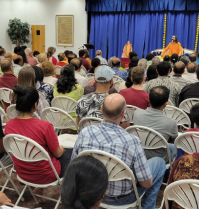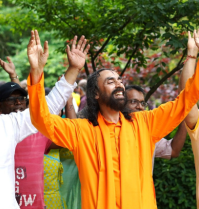4S’ of Spiritual Journey
Bhakti Yog / July 14, 2015

The spiritual journey brings us many goodies and delights. Along the way, we are also taught the principle of 4S namely, sadhana (meditation), seva (service), satsang (three-fold path of Bhakti), and sharanagati (surrender).
The first S along this journey is sadhana or meditation. Sadhana is the practice that is done to elevate the mind and attach it to God and Guru. This is your quality time with Radha Krishna so guard it zealously. Sit at a place free from most worldly disturbances – in the park, in the temple, by the altar at your home, at the beach, in your backyard – a place where it is relatively easier to focus on Radha Krishna and your Gurudev.
According to the scriptures, the best time to mediate is two hours immediately prior to sunrise (Brahma Muhurt). If you can wake up and follow this practice for a week, you’ll realize there is a certain calmness in the atmosphere, when even the birds are not yet up, that boosts the concentration. Additionally, in the morning the mind tends to be empty making it easier to focus on God and Guru. Once you begin doing your worldly duties, the mind begins to fill up worldly images and thoughts. Another good option is to meditate before going to bed. After you’ve taken care of everyone else, you can finally turn your mind toward your God and Guru and thank them for all the graces and blessings showered upon you. However, you can decide the time for sadhana according to your convenience. You can even split it up and do it in two sessions at different times of the day.
Click here to watch this interview of Swami Mukundananda where he discusses why sadhana is important in this modern age.
Seva or service is the second S on this journey. It is done in accordance with the desire of God and Guru, with the idea of pleasing them. According to the scriptures, we can serve God and Guru in three ways – with dhan (wealth), tan (time or volunteer work), man (mentally in the mind). The easiest way to serve is by donating money to God and Guru. The scriptures suggest contributing 10% of your annual income. When you give, do so with most sincere, heartfelt sentiments that you are serving God and Guru by giving this money. Do not seek anything in return for the seva—let it be offered selflessly. Also, do not harbor the pride of having done seva; be grateful for the opportunity to serve. Each year, pledge to increase your seva incrementally such that you hit the goal of 10%.
Higher than serving with wealth is serving with tan, or body. Volunteer work means as you physically work in the service of God and Guru, you think of them; they are in your thoughts and mind, for the duration of the service. After all, they are the reason for performing the activity. Once again, in performing this service, as you think of God and Guru, keep in mind the sincerity of thoughts and genuineness of sentiments.
Lastly, the highest form of service is through the man, or with the mind. This takes it up a whole notch from the previous one. The idea here is to always harbor the desire to serve God and Guru in the mind. So every act we perform is in service to God and Guru. This really implies that we have to think of God and Guru 24/7 x 365; never stop thinking of them; think of them every second of every minute of every hour of every day. Tall order!
Click here to watch this question and answer session wherein Swami Mukundananda discusses the ways in which to serve God.
The third S along the spiritual path is satsang which brings to life the idea of Trida Bhakti i.e. hearing (śhravaṇam), chanting (kīrtanam), and remembering (smaraṇam), the names, forms, abodes, pastimes, virtues, and associates of God. Satsang provides a forum to gather with others to hear, discuss, chant, remember God in all his glory. Each and every one of us is blessed in a myriad of ways so the list of stories to share is never ending. It never gets boring or old.
Click here to see if there is a JKYog satsang center by you. Click here for a quick clip by Swamiji explaining the concept of Trida Bhakti.
Lastly, the fourth S stands for Sharanagati meaning surrender. This is the true essence of Bhakti. Surrender is the art of accepting everything as the grace of God and Guru. When we do this, the unfavorable or the not so good circumstances also become good. Surrender means to unite our will with the will of God and Guru and not to harbor any independent desire for self-happiness. In other words, it requires us to be completely selfless in everything we do. We cannot harbor any desires whatsoever; the only desire that should exist in our mind is the desire to make God and Guru happy. If this is the standard, think of where you stand. Introspect on your selfishness. How far is your surrender?
Click here to read about the six aspects of surrender as explained by Swami Mukundananda in verse 18.62 of the Bhagavad Gita. Click here to watch this beautiful 15 min video wherein Swamiji explains the same concept lucidly.
Now that you’ve read about the concept of 4S, on a scale of 1-10, how would rate yourself on each dimension? How will you motivate yourself to move forward and scale it up in the second half of the year?

























